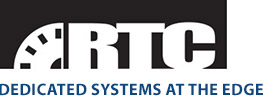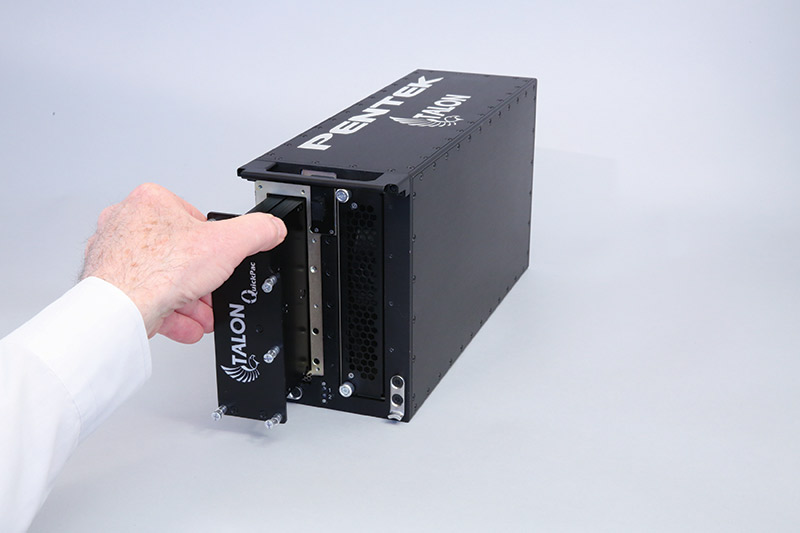Pentek Adds Digital I/O Capability to Talon Extreme Rugged 1/2 ATR Recorder Family
Pentek, Inc., today announced the most recent addition to the Talon RTX small form factor (SFF) series of high-speed, high-performance, rugged recording systems, the Model RTX 2596, capable of recording and playing back four Serial Front Panel Data Port (sFPDP) data streams.
The Talon RTX 2596 is fully-deployable and ideal for capturing digitized sensor data from radar systems and RF downconverters that use the lightweight VITA 17.1 sFPDP protocol. It supports baud rates to 4.25 GBaud and has options for multi-mode or single-mode optical interfaces. The VITA 17.1 specification is fully implemented, providing standard sFPDP features such as Flow Control, Copy/Loop Mode and CRC error checking. The Talon RTX 2596 also provides playback capabilities, allowing users to operate the system as either a receiver or a transmitter.
The Talon RTX 2596 SFF recorder weighs just 18 pounds and is designed for extreme operating environments. Optimized for SWaP (size, weight and power), the rugged sealed ½ ATR recorder is available with up to 61 TB of removable SSD storage.
“The Talon RTX SFF recorders have undergone extensive independent laboratory testing to assure they can operate in some of the toughest environments,” said Chris Tojeira, Recording Systems Director, Pentek. He added, “We’ve tested to a wide array of military standards in the MIL-STD 810 and 461 specifications to assure that whether in a UAV, an aircraft pod or shipboard, our recorders will perform at the highest level.”
Extremely Rugged, Sealed Design
Not only are RTX SFF recorders engineered to operate in the toughest environments with high levels of shock and vibration, the chassis also keeps all electronics sealed from the external environment. The ½ ATR chassis uses military standard circular I/O connectors to control RF emissions while protecting the recorder’s electronics from humidity, water, dust, sand and salt fog.
The Talon RTX SFF chassis seals the internal electronics from the outside environment by extracting heat through conduction to an air-cooled inner plenum. A thermostat-controlled, removable fan pulls air into the front of the chassis, through the plenum and then out the back of the chassis. Only the fan is exposed to the outside environment, assuring all system electronics are protected in the sealed chassis. The inner plenum can be replaced to provide other cooling options, such as liquid or conduction cooling.
Designed to operate from -40ºC to +60ºC, these recorders can handle most thermal environments, making them ideal for UAV’s, aircraft pods, tight equipment bays, military vehicles and most outdoor environments.
High-Speed Data Storage and Security
Pentek’s QuickPac drive pack is easily removed from the recorder via a set of captive thumb screws on the front panel. Fully sealed with environmental gasketing, an empty QuickPac drive pack can replace a full one for short down times and extended missions. A companion offload system for the QuickPac drive pack is available so the recorder can be redeployed while the recorded data is transported and reviewed via the offload system at a ground facility. The QuickPac drive pack holds up to 61 TB of SSD data storage and supports RAID levels 0, 5 or 6.
For secure applications, a separate operating system drive can be removed, allowing users to extract all non-volatile memory from the system in just a few seconds.
Mission Computer Capable
Talon RTX SFF recorders with the Intel Core i7 7700K, 7th Generation Quad Core 4.2 GHz processor and 8 GB DDR4 DRAM, are expandable to 16 or 32 GB with enough processing power to act as the primary mission computer when needed, delivering state-of-the-art processing for mission applications and control, with minimal impact on the overall power budget of the system.
Ease of Operation
Pentek’s SystemFlow® software interface is integrated into every Talon recorder. The software includes the graphical user interface (GUI) that is used to control the recorder with point-and-click configuration management, using a client/server communication interface. An NTFS file system ensures immediate access to recorded files, and an application programming interface (API) supports custom user applications and control. The system can be controlled remotely via the Gigabit Ethernet interface available on one of the MIL-STD circular connectors. Signal analysis tools include a virtual oscilloscope, spectrum analyzer, and spectrogram to monitor signals before, during and after data collection.
Available Options and Simulation Package
The Talon SFF recorders offer an optional GPS receiver for precise time and position stamping. Additional QuickPac drive packs with 3.8 to 61 TB are available. Computer I/O on all models includes Gigabit Ethernet, USB 3.0, RS-232 and HDMI.
Pentek’s SystemFlow Simulator provides a “test drive” of the SystemFlow recording software installed on all Talon recording systems. The simulator allows users to operate the standard GUI and the SystemFlow API.
Pentek, Inc
www.pentek.com

